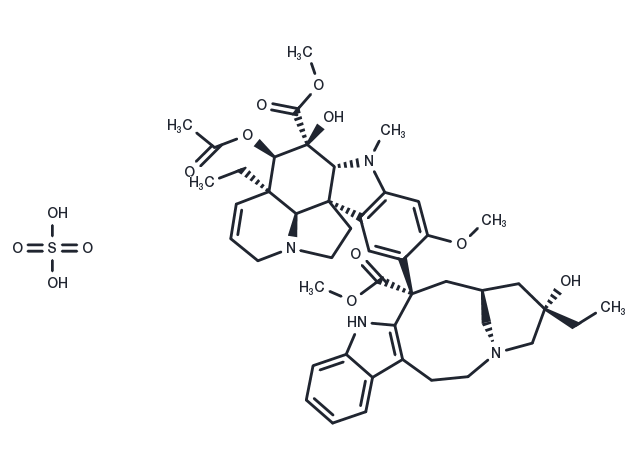store at low temperature
Powder: -20°C for 3 years | In solvent: -80°C for 1 year

Vinblastine sulfate (Vincaleukoblastine sulfate salt) can inhibit the formation of microtubule, it also inhibits nAChR(IC50=8.9 uM).

| Pack Size | Availability | Price/USD | Quantity |
|---|---|---|---|
| 5 mg | In stock | $ 50.00 | |
| 10 mg | In stock | $ 54.00 | |
| 25 mg | In stock | $ 64.00 | |
| 50 mg | In stock | $ 84.00 | |
| 100 mg | In stock | $ 97.00 | |
| 1 mL * 10 mM (in DMSO) | In stock | $ 63.00 |




| Description | Vinblastine sulfate (Vincaleukoblastine sulfate salt) can inhibit the formation of microtubule, it also inhibits nAChR(IC50=8.9 uM). |
| Targets&IC50 | nAChR:8.9 μM |
| In vitro | The average terminal half-lives of Vinblastine is 14.3 h. When incubated in freshly isolated rat hepatocytes, VLB penetrates rapidly and intensely into the cells, probably through a passive diffusion mechanism followed by tight cellular binding[3]. Vinblastine inhibits the angiogenic response induced by adrenomedullin and is also positive for mitotic slippage, causing micronuclei in mononucleate cells with cytokinesis block[4]. vinblastine gives significant increase in micronucleated mononucleated cells at concentrations that produced approximately 50% cell death and cytostasis or less as calculated using RPD, RICC and RCC[2]. |
| In vivo | Vinblastine is a widely used anticancer drug with undesired side effects [6]. A combination of VBL and RAP at very low doses against human HCC gets a satisfactory antiangiogenic effect in vivo[4]. The clinically relevant dose of vinblastine inhibits palmitoylation of tubulin in vivo in CEM cells (effect on depalmitoylation of tubulin)[5]. |
| Kinase Assay | Cell based receptor autophosphorylation assays: Autophosphorylation of PDGFR family kinase assays are cell-based enzyme-linked immunosorbent (ELISA) assays using CHO cells expressing wild-type PDGFRβ, chimeric protein PDGFRβ/c-Kit, and PDGFRβ/Flt3 which contain the extracellular and transmembrane domains of PDGFRβ and the cytoplasmic domain of c-Kit, and Flt-3. Cells are grown to confluency in 96-well microtiter plates under standard tissue culture conditions, followed by serum starvation for 16 hours. Briefly, quiescent cells are incubated at 37 °C with increasing concentrations of Tandutinib for 30 minutes followed by the addition of 8 nM PDGF-BB for 10 minutes. Cells are lysed in 100 mM Tris, pH 7.5, 750 mM NaCl, 0.5% Triton X-100, 10 mM sodium pyrophosphate, 50 mM NaF, 10 μg/mL aprotinin, 10 μg/mL leupeptin, 1 mM phenylmethylsulfonyl fluoride, 1 mM sodium vanadate, and the lysate is cleared by centrifugation at 15,000 g for 5 minutes. Clarified lysates are transferred into a second microtiter plate in which the wells are previously coated with 500 ng/well of 1B5B11 anti-PDGFRβ mAb and then incubated for 2 hours at room temperature. After washing three times with binding buffer (0.3% gelatin, 25 mM HEPES, pH 7.5, 100 mM NaCl, 0.01% Tween 20), 250 ng/mL of rabbit polyclonal anti-phosphotyrosine antibody is added and plates are incubated at 37 °C for 60 minutes. Subsequently, each well is washed three times with binding buffer and incubated with 1 μg/mL of horseradish peroxidase-conjugated anti-rabbit antibody at 37 °C for 60 minutes. Wells are washed prior to adding 2,2'-azino-bis(3-ethylbenzthiazoline-6-sulfonic acid), and the rate of substrate formation is monitored at 650 nm. |
| Cell Research | Six-well treatment plates are set up that contained 5 × 104 cells/mL in each well, suspended in 3 mL culture medium, and these are treated with vinblastine for 3 h followed by 21 h growth. (Only for Reference) |
| Source |
| Synonyms | NSC49842, Vincaleukoblastine sulfate salt |
| Molecular Weight | 909.06 |
| Formula | C46H58N4O9·H2SO4 |
| CAS No. | 143-67-9 |
store at low temperature
Powder: -20°C for 3 years | In solvent: -80°C for 1 year
DMSO: 90.9 mg/mL(100 mM)
Ethanol: < 1 mg/mL (insoluble or slightly soluble)
You can also refer to dose conversion for different animals. More
bottom
Please see Inhibitor Handling Instructions for more frequently ask questions. Topics include: how to prepare stock solutions, how to store products, and cautions on cell-based assays & animal experiments, etc.
Vinblastine sulfate 143-67-9 Autophagy Cytoskeletal Signaling Neuroscience Microtubule Associated AChR inhibit Vincaleukoblastine Vincaleukoblastine Sulfate Microtubule/Tubulin Inhibitor Vinblastine Sulfate NSC 49842 Vinblastine NSC-49842 NSC49842 Vincaleukoblastine sulfate salt inhibitor
